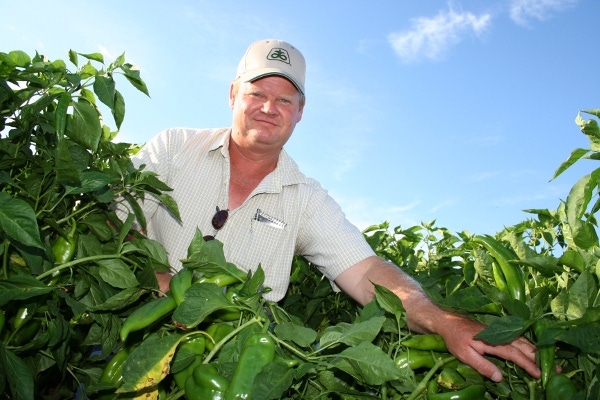
New Mexico crop farmer Don Hartman successfully evolves from furrow irrigation to drip irrigation;Hartman says drip irrigation likely saved his farm operation financially;Drip irrigation has increased yields, decreased water usage and other input use;Chile pepper industry needs verticillium wilt resistant variety and mechanical harvester to survive.

Don Hartman is a proud, frugal farmer who runs his pickup truck for about 10 years before turning the keys over to a hired man for additional farm chores. Major purchases are intricately scrutinized before purchase orders are ever generated.
Seven years ago, Hartman and his wife Cheryl, green chile pepper, upland cotton, and grain sorghum farmers in southwestern New Mexico, made the weighty decision to transition the farm’s water delivery system from furrow irrigation to subsurface drip irrigation. Cost containment was viewed as the best strategy to economically survive.
This spring, the Hartmans, owners and operators of Don Hartman Farms, Deming, installed subsurface drip on the second of their three farms, a 165-acre parcel on their owned and rented 400-acre operation in the gorgeous Mimbres Valley in Luna County. The couple’s long-term commitment to drip has shaved costs and tempered some long-term economic concerns.
“I probably wouldn’t be farming now if I hadn’t converted to drip,” said Hartman as he peered across his truck bed to a green chile field near maturity. “Drip irrigation saves so much. If you can afford the initial investment, it’s a no-brainer.”
Stories like the Hartman’s are increasing as farmers search for ways to weather drought and skyrocketing input costs in the Southwest and West. The Deming area receives 7 to 9 inches of rain annually, most during the summer monsoon season.
Hartman, 42, and the parcel’s landowner paid about $2,500 per acre for this year’s drip expansion which includes a mid-level system from Netafim. The landowner qualified for cost-share dollars through the Natural Resources Conservation Service’s environmental quality incentives program or EQIP. Hartman signed a 10-year lease on the parcel to ensure the landowner would recoup the expenses.
“The cost of the system depends on the bells and whistles,” Hartman said. “It’s like a car – you can buy an economy model or a Mercedes Benz depending on the preferred features. The basic controller cost was about $1,200. We installed a $2,600 controller for the additional capabilities.”
Hartman’s drip system is hardwired to his home computer and can be accessed on the road with the software pcAnywhere.
Hartman said, “I can sit at home and monitor the drip system and apply fertilizer or go on vacation with my laptop and check on the water.”
His projection to recoup the drip system capital costs is about five years.
Hartman’s drip system includes 13 mil drip tape buried 8 to 10 inches under the flat field surface with 38-inch centers. The emitters are 12 inches apart. In the case of chile, the crop is planted above the tape. Chile is the No. 1 cash crop in Luna County.
Water from wells enters the filter station building which houses six, bright red colored, round-shaped sand media filters where garnet sand snags dirt and other small particles from the water.
Hartman uses varying drip flow rates depending on the need. In extremely hot weather, about one-quarter inch of water per hour is emitted for eight hours daily every fourth day.
Water tops cost-saving list
Hartman continues to bank the savings rendered from the drip system. Water tops his cost-saving list at about $25,000 to $30,000 annually. With drip, water use in the chile crop has declined from 36 inches to 30 inches per season. In the upland cotton crop, drip sliced the water requirements in half from 36 inches to 18 inches with similar reductions in grain sorghum.
Spoon-feeding fertilizers through the drip tape, including UN-32 liquid nitrogen and phosphoric acid, has cut fertilizer use by about 50 percent. Hartman adds about 2 pounds of boron/acre in the drip per season to make up for low levels in the soil. An independent soil laboratory monitors fertility levels.
“When using a high-tech system, the available tools should be utilized to maximize efficiency,” Hartman said. “Drip applies the product to the root zone. Previously we sidedressed the fertilizer and moved it with surface water. That’s not very efficient.”
Most herbicides, including Treflan and Prowl, are soil applied. Most insecticides are drip applied providing a 40-day window of pest control.
Soil types on the Hartman farm range from heavy clay to pure gravel streaks in the same field. Hartman has higher flow tape in the gravel areas to provide adequate water and fertilizer.
Drip also reduces tractor hours in the field. Not wetting the soil surface germinates fewer weed seeds. The fields are cleaner with less cultivation, time, labor, and diesel required.
“You don’t have to sit on top of a sprayer and smell it all day,” noted the second-generation farmer.
Hartman shared his drip irrigation experiences this fall with pepper researchers from around the world during a farm tour held in conjunction with the International Pepper Conference in Las Cruces.
“My chile pepper yields with furrow irrigation totaled about 15 tons based on two crop pickings. I now get 20 to 30 tons from two pickings with drip,” Hartman told the chile crowd. “My cotton yields increased from 2.5 bales/acre to 3.5 to 4 bales/acre.”
Chile quality has also improved, Marvin Clary told the crowd. Clary is an agronomist with Border Foods in Deming. Hartman grows chile under contract for Border Foods.
“Growing chile under drip develops a thicker wall in the pepper which improves fruit quality,” Clary said.
Daytime soil temperatures in a drip taped-field are 10 to 15 degrees higher than a furrow-irrigated field. This increases heat units earlier in the season which allows the plant to mature faster, says Clary.
A second chile picking is difficult under furrow irrigation since wet fields tend to reduce chile quality. Drip-applied water containing fertilizer allows growers to extend the growing season. This can increase total tonnage/acre by at least 4 to 5 tons and increase quality in second-picked fruit, Clary says.
“With drip, I harvest chile and irrigate at the same time,” Hartman said. “This makes for fresher fruit, a better crop, and improved quality grades.”
Maintenance is required with all equipment. After harvest, Hartman runs sulfuric acid and chlorine through the tape to reduce water blockages. Rodents occasionally chew holes in the tape that require repair.
Hartman estimates irrigation in Luna County at about 90 percent drip and 10 percent furrow.
Agriculture’s switch to drip has helped raise the water table in the area, he says.
Stephanie Walker, New Mexico State University Extension vegetable specialist, says about 70 percent of the state’s chile pepper acreage is under drip.
The single drawback to drip, Hartman says, is related to the practice of minimum tillage in drip fields. Since the topsoil texture is smooth, high winds in the spring can create dust capable of “burning” the crop.
Looking to the future, what are the top issues needed for the chile industry to remain profitable? Hartman believes the development of verticillium wilt disease-resistant varieties and mechanical harvesters are the key components to survival; and the sooner the better.
About the Author(s)
You May Also Like





